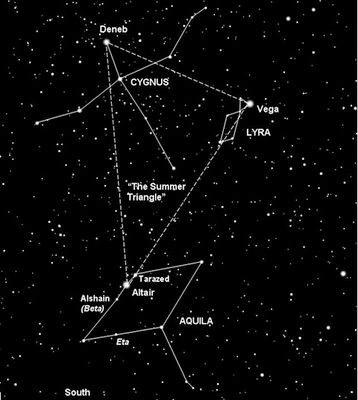 Our July 2014 Constellation of the Month is
not one of the official 88 constellations, but it is nonetheless a prominent
and memorable shape made by stars. The
Summer Triangle is comprised of the brightest stars of 3 constellations. You can't miss them; they are the brightest
stars in the East an hour or two after sunset, about midway between the eastern
horizon and overhead.
Our July 2014 Constellation of the Month is
not one of the official 88 constellations, but it is nonetheless a prominent
and memorable shape made by stars. The
Summer Triangle is comprised of the brightest stars of 3 constellations. You can't miss them; they are the brightest
stars in the East an hour or two after sunset, about midway between the eastern
horizon and overhead.
The brightest of the 3 stars – Vega, in the
constellation of Lyra (the Harp) – is the easternmost one. To the west and north is Deneb, in the
constellation Cygnus (the Swan, also known as the Northern Cross). To the west and south of Vega is Altair in
the constellation Aquila, the Eagle.
The Summer Triangle is a good
non-constellation star pattern ("asterism") to get to know. (Asterisms can also be well-known parts of constellations, e.g., the Big Dipper is a part of the constellation Ursa Major). The Summer Triangle is visible about half the year, and it can
be useful as a starting point for finding other constellations -- as we'll describe
in coming months.
Vega is an important star, because it was
used to define the zero point in the scale used to specify the apparent
brightness of stars – the magnitude. I
say "apparent" brightness, because it describes how bright a star
appears to us on earth. A very bright
star (one with a large "absolute" brightness) which is very far away
can appear to us as less bright than a star of average brightness which is much
closer to earth. "Close" in
astronomical terms, could be 50 trillion miles away.
So, Vega was defined as having a magnitude of
0. And the brightness of other stars was
measured in relation to that. In order
to avoid very large numbers, the magnitude scale is logarithmic, like the
Richter scale for earthquake intensity.
A magnitude 1 star is 2.5 times as bright as a magnitude 0 star. And a magnitude 2 star is 2.5 times fainter
than that. So a magnitude 2 star is 2.5
x 2.5 (6.25) times fainter than a magnitude 0 star.
Stars brighter than 1.5 magnitude are called
1st magnitude, from 1.5 – 2.5 are 2nd magnitude and so
on. The naked eye in Ridgefield can
probably see no fainter than 4th
magnitude, due to light pollution. The other two stars in the Summer Triangle –
Altair and Deneb – are magnitudes 0.77 and 1.2, respectively. So they are also 1st magnitude
stars. By way of comparison, the stars
in the Big Dipper are magnitude 2 stars.






